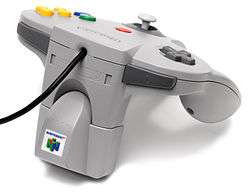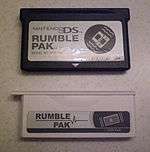Rumble Pak

The Rumble Pak (Japanese: 振動パック Hepburn: (Shindō Pakku) is a removable device from Nintendo which provides force feedback while playing video games. Games that support the Rumble Pak cause it to vibrate in select situations, such as when firing a weapon or receiving damage, to immerse the player in the game. Versions of the Rumble Pak are available for the Nintendo 64, the Nintendo DS, and the Nintendo DS Lite. A select few Game Boy Color and Game Boy Advance games use a similar technology built into the game cartridge. The use of external Rumble Paks, since their introduction, is rare today, mainly because the force feedback vibration that they provide has become a built-in standard feature in almost every home video game console controller since.
Nintendo 64
The original Rumble Pak, designed for the Nintendo 64 controller, was released in April 1997 in Japan, July 1997 in North America, and October 1997 in Europe. It requires two AAA batteries and is inserted into the controller's memory cartridge slot, which prevents simultaneous use of the Controller Pak. This usually has little impact, as Nintendo 64 games are cartridge based and have the ability to store saved data in the cartridge, but for games that support the Controller Pak, it is possible to switch between accessories at certain points, a method known as "hot swapping".[1]
The Rumble Pak was introduced bundled with the game Star Fox 64 (known as Lylat Wars in the PAL region) and made available as a separate purchase two months later. Rumble Pak support soon became a standard for N64 games. Launch titles Wave Race 64 and Super Mario 64 were re-released in Japan in July 1997 with Rumble Pak support.[2][3]
Several thirdparty versions of the Rumble Pak, such as the Tremor Pak, followed. Some draw power from the controller instead of batteries, but the lower power makes them less effective. The TremorPak Plus allows a memory card to be inserted simultaneously, eliminating the need to switch between two accessories.[4] The Nyko Hyper Pak Plus contains internal memory and allows the user to adjust the amount of feedback between "hard" and "too hard".[5]
Reception
When reviewing Star Fox 64, IGN praised the Rumble Pak, stating that it "adds an unusual burst of arcade ecstasy to the game".[6]
IGN's Levi Buchanan wrote an 11th birthday article on the Nintendo 64's Rumble Pak, describing how its influence led to rumble being "an industry standard within a single generation".[7] He said that it is bulky and heavy when attached to the Nintendo 64 controller, but that "[t]he trade-off was actually worth it".
More recently, in TWGNews's "Top 10 Controller Innovations" article, the Rumble Pak is listed as #8, saying "the Rumble Pak added a whole new level of immersion to the fifth generation of video games".[8]
Nintendo DS

The Rumble Pak for the Nintendo DS is an official DS Option Pak shaped like a Game Boy Advance cartridge and is designed to be inserted in the system's Game Boy Advance game slot (SLOT-2). It was the first Nintendo DS accessory to utilize the slot.[9] In North America, it was first made available bundled with Metroid Prime Pinball,[10] but is now available through other promotions[11] or as a stand-alone purchase from Nintendo's online store. The accessory was released differently in Europe due to a delay of Metroid Prime Pinball in that region. Various DS games supporting the Rumble Pak (Metroid Prime Hunters, Mario & Luigi: Partners in Time, and 42 All-Time Classics) had been released in Europe before the accessory was available. The accessory was eventually released as a pack-in with the game Actionloop in the UK.
Although the Rumble Pak works with both the Nintendo DS and the redesigned Nintendo DS Lite, it protrudes from the Nintendo DS Lite when inserted, as do Game Boy Advance cartridges, because of the Nintendo DS Lite's smaller size. For this reason, a smaller version of the Rumble Pak is available in Japan, which is flush with the system when inserted. It was initially available in just black, but other colors produced by unlicensed accessory manufacturer eWin, such as white (see picture), have been released. Other color variations been released by eWin.
Some flash cartridges for the Game Boy Advance (SLOT-2 flash cartridges) have a built-in rumble feature that, when used in tandem with a SLOT-1 flash card on a Nintendo DS, can provide rumble as if it were an ordinary Rumble Pak.
The Nintendo DS Rumble Pak is incompatible with the Nintendo DSi and Nintendo DSi XL, as both consoles lack a SLOT-2. However, none of the games supporting the Rumble Pak require it for proper operation of the game, meaning that the games themselves are still compatible with DSi (some software titles, such as Nintendo DS Browser and Guitar Hero: On Tour, have SLOT-2 peripherals that are required for operation, and are hence incompatible with DSi and DSi XL, although the former already has an alternative version made specifically for the Nintendo DSi and later consoles). Despite Nintendo DSi and Nintendo DSi XL's lack of SLOT-2, some Nintendo DS titles released after the Nintendo DSi's launch continued supporting the Rumble Pak accessory, likely due to the fact the Nintendo DS Lite console was sold concurrently with the Nintendo DSi and Nintendo DSi XL.
Reception
The Nintendo DS Rumble Pak was initially met with harsh criticism as reviewers pointed out the limited number of games compatible with the card[12] (at the time only four were compatible). Reviewers also pointed out the annoying "squealing noise" or "electronic chirp"[13] that the device made when 'rumbling'. IGN stated that "Good thing it's free, because at this point we wouldn't bother buying it as an extra.".[13] Up until the removal of the expansion slot from later Nintendo DS models, the DS Rumble Pak was supported by 51 games in total.[14]
Game Boy line
There is no Rumble Pak for the Game Boy line. There are several games for Game Boy Color and Game Boy Advance that support rumble. Since the Game Boy Color hardware does not include native force feedback and has no extra slot for a separate peripheral, all games supporting this feature had it built into the game cartridge itself. These games that have this feature require an extra AAA battery (in addition to the two AA batteries required to power to the Game Boy Color) that is inserted into the cartridge to power the vibrating motor.
The Game Boy Advance games draw power directly from the Game Boy Advance itself and do not require an external power source. There are only two Game Boy Advance games with built-in rumble: Drill Dozer and WarioWare: Twisted!. The latter is a motion detecting game that vibrates slightly when the game is tilted through use of a piezoelectric gyroscope.[15]
See also
References
- ↑ Johnston, Chris (1997-05-23). "Rumble Pak Titles On the Rise". GameSpot. Retrieved 2006-06-25.
- ↑ "Super Mario 64 Info". GameFAQs. Retrieved 2006-07-12.
- ↑ "Wave Race 64 Info". GameFAQs. Retrieved 2006-07-12.
- ↑ IGN Staff (1999-03-03). "TremorPak Plus". IGN. Retrieved 2006-07-12.
- ↑ IGN Staff (1998-06-12). "Hyper Pak Plus". IGN. Retrieved 2006-07-12.
- ↑ Perry, Doug (1997-05-06). "Star Fox 64 review". IGN. Retrieved 2008-09-12.
- ↑ Buchanan, Levi (2008-04-03). "IGN: Happy Birthday, Rumble Pak". IGN. Retrieved 2008-09-12.
- ↑ "TWGNews Top 10: Control Innovations". TWGNews.com. 2008-09-09. Archived from the original on September 14, 2008. Retrieved 2008-09-12.
- ↑ "Official Metroid Prime Pinball page". Nintendo of America. Retrieved 2009-02-28.
- ↑ Harris, Craig (2005-08-22). "Metroid Pinball Rumbles". IGN. Retrieved 2006-06-25.
- ↑ Harris, Craig (2006-05-02). "Free Rumbles with Metroid Prime Hunters". IGN. Retrieved 2006-06-25.
- ↑ "CNET reviews - Nintendo DS Rumble Pak". Retrieved 2008-09-12.
- 1 2 "IGN First Look: DS Rumble Pak". Retrieved 2008-09-12.
- ↑ "Nintendo DS Rumble Pak Compatibility List". Retrieved 2009-09-29.
- ↑ Ceramic Gyro, NEC-Tokin
